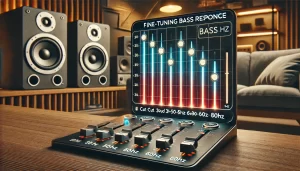How to Set the EQ for Subwoofer?
 We researched for over 30 hours and conducted practical tests to determine how to set the EQ for a subwoofer. We share our verdict with you. The subwoofers are important constituents of a home audio and theater system, which provide that deep, low-frequency sound when one is listening to music or watching a movie. The thing is, like any audio device, these need settings and tuning properly. Among the most important adjustments are the settings of subwoofer EQ, which ensure that the bass feels full without being overdone and unbalanced. A well-set EQ for subwoofer ensures that low-end frequencies will integrate properly with your other speakers, making for smooth listening.
We researched for over 30 hours and conducted practical tests to determine how to set the EQ for a subwoofer. We share our verdict with you. The subwoofers are important constituents of a home audio and theater system, which provide that deep, low-frequency sound when one is listening to music or watching a movie. The thing is, like any audio device, these need settings and tuning properly. Among the most important adjustments are the settings of subwoofer EQ, which ensure that the bass feels full without being overdone and unbalanced. A well-set EQ for subwoofer ensures that low-end frequencies will integrate properly with your other speakers, making for smooth listening.
In this tutorial, we are going to show you the main steps for setting up the EQ on your subwoofer to achieve the best sound.
We’ve honestly reviewed some products for you. Here they are:
Understand What a Subwoofer Does
Now, let’s explore the ins and outs of EQ settings, but first, let’s grasp what a subwoofer actually accomplishes in your sound system. Unlike speakers, capable of producing both mid and high frequencies, a subwoofer is designed specifically to produce low-frequencies–most times between 20Hz and 200Hz. Such types of frequencies sound less and feel more, and in most cases, manifest in deep rumbling in music and low-end explosion in cinema.
Here are the most important jobs of a subwoofer.
Deep Bass Reproduction: Subwoofers reproduce that extreme low-end range of sound, and such sound cannot be produced well with smaller speakers.
Increased Impact: That feeling of the bass brings in that emotional value in music and cinematography in which such explosion, rumbling sound, and beat become so engrossing.
Balance Out Sound System: A subwoofer complements your speakers to cover full range between low and high sound frequencies
Choosing Where to Position Your Subwoofer
Where your subwoofer is placed can make a significant impact in both your sound of bass and integration with your speakers. Subwoofers react to room acoustics, and positioning them can make them sound even better, but muck them up, too.
Here are a few important tips for best placement:
Corner Position: Having your sub in a corner can boost your output of bass, with walls enhancing low frequencies, but make your sound boom and require a little work in terms of subwoofer EQ to level it out. Use this in larger rooms, where added bass will have a positive effect.
Against a Wall: In case corner placement creates too boomy a sound, try having your sub placed against one of your walls. That will produce your room with a balanced sound with a lot of bass, but not too much.
The Crawl: Put your sub temporarily in your listening position and then crawl around your room, listening for at which position your bass will sound best. Once you have discovered your best position, move your sub to it for best sound.
Setting Crossover Frequency
The crossover frequency is at which your sub takes over for your speakers’ mains. Set your crossover too high, and your sub will encroach onto your speakers‘ midrange, and your sound will sound muddled. Set your crossover too low, and your sound will lack a little of your speakers’ warmth and punch, and your mids will sound thin.
Here’s how to tune your crossover frequency:
Optimum Range: Most home audio works best with a range between 80 and 120Hz
- For larger speakers (floor-standing speakers, for example, or tower speakers), a lower crossover point, closer to 80Hz, will work best. That will enable your subwoofer to fill in the very low-frequencies and not conflict with your speakers.
- For satellite speakers, a high crossover point, closer to 100Hz, 120Hz, will work best, and will enable your subwoofer to fill in gaps in sound generated by smaller drivers.
Avoid Overlap: What you’re searching for is a transition between your speakers and your subwoofer that is unobtrusive and smooth. Ideally, your subwoofer will not dominate your speakers’ low-mid range, but will enable them to cover it.
Adjusting the Subwoofer Level
After crossover is set, it’s now time to get the sub level, for which, in effect, changes volume of the subwoofer relatively to the remaining of your speakers. It has been an essential step since more bass will over-power your whole system while its little will cause low end shortage.
Starting Point: Set the subwoofer‘s level control to its middle point-about 50-60% being a good mark-and adjust accordingly. Then, play back music or movie content with an easily recognizable bass line and take note of your sub/main balance.
Fine-tuning: This can be increased or decreased based on how well the bass blends in with your speakers. It needs to be present but not dominating. The perfect setting for subwoofer levels is where, when properly tuned, the bass is just ‘there’ rather than noticeable or intrusive.
Equalization for Fine-Tuning Bass Response
With the subwoofer placed, the crossover set, and the level matched, it‘s time to fine-tune the EQ for subwoofer. The goal here is to enhance the subwoofer’s low frequencies without overemphasizing any particular range. Fine-tuning your subwoofer EQ will help you achieve smooth, clear bass with proper integration into the rest of your system.
Subwoofer EQ Adjustment Tips:
Start with a Flat EQ: Start with the EQ in flat, and without boosts or cuts, adjust. This way you will be fairly sure you’re listening to a near-neutral sound to begin with.
Muting Undesirable Frequencies: If there’s any unwanted resonance or muddiness in the low-end, you may want to cut frequencies between 30-50Hz. This area can sometimes be a bit rumbly if you’ve got your sub in the corner or near a wall. Cutting this range cleans up the bass and makes the sound more contained.
Improving Mid-Bass Punch: If the bass sounds like it lacks punch, a slight lift around 60-80Hz can help lend weight and definitiveness to the bass without cluttering the overall sound with indistinct muddy notes and vocals.
Over-Boosting – Avoid the Temptation: One can have this great temptation to boost those bass frequencies. Over-boosting results in distortion and unnatural sound. If one feels he needs to, instead of over-boosting, try to cut problem frequencies and then do subtle boosts to balance.
Room Mode Correction: Some subwoofers/AV receivers have room correction software built into them that automatically runs an EQ to counteract the acoustics of the room. If your system has this, run through the calibration process before making any manual adjustments.
Room Calibration and Listening Tests
Well, most modern AV receivers and HT systems include their own variety of room calibration system, be it Audyssey, Dirac Live, or YPAO. With the use of microphones, they will measure the acoustics of your room and automatically adjust the subwoofer settings of your system to optimize the sound.
Of course, while these systems can be quite effective, it’s always a good idea to make some manual adjustments afterward to perfect the sound. Play a variety of bass-heavy content and sit in your primary listening position to test the results, paying attention to how the subwoofer integrates with your speakers and whether the bass is even and smooth.
Review and Alter Your Settings Regularly
Room dynamics may alter with time as you move furniture around or even put in newer gear. Over time, you will get accustomed to certain bass levels and even want to return to the settings for a second opinion. As such, revisiting subwoofer EQ periodically, say, every few months, or following each major change that happens within the listening environment, is highly advisable.
We finally say
Setting the subwoofer EQ is another fun way to further enhance the home audio. By correctly placing a subwoofer, adjusting its crossover frequency, and making fine adjustments in its level, you can use equalization for adjusting the bass response to perfectly balance a dynamic low end which complements the whole sound system. Experiment with settings to find out what works for your room and preferences in listening.
Thus, the following steps can be followed to realize clean, punching, very well-balanced bass, and most definitely bring about the greatest changes in musical listening and cinema experience.










